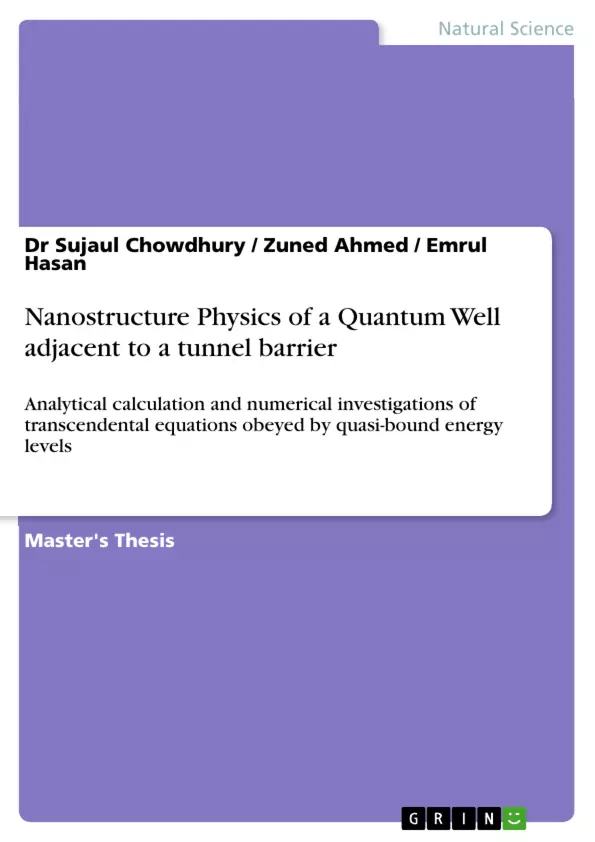We have investigated Nanostructure Physics of a Quantum Well (QW) adjacent to a tunnel barrier. On the other side of the QW, we have a barrier layer of semi-infinite thickness. The book contains thorough and complete analytical calculations leading to two transcendental equations obeyed by quasi-bound energy levels of the QW. The book also contains numerical investigation of parametric variations of the quasi-bound energy levels. The variations are quite unexpected. For some values of tunnel barrier width and height, each quasi-bound energy level yields two allowed energy levels. The two equations reduce to those for isolated QW in proper limiting values of parameters. The book contains necessary background on Quantum Mechanics, Microelectronics and Nanostructure Physics to enable readers assimilate the book completely.
Inhaltsverzeichnis (Table of Contents)
- Chapter I: Background on Quantum Mechanics
- 1.1 Wave equation of a free particle: Schrödinger equation
- 1.2 Schrödinger equation of a particle subject to a conservative mechanical force
- 1.3 Allowed values of an observable
- 1.4 Eigenvalue equation, eigenfunction and eigenvalue
- 1.5 Time-independent Schrödinger equation and stationary state.
- 1.6 Continuous and discontinuous function
- 1.7 Finite and infinite discontinuity
- 1.8 Admissibility conditions on wave function
- 1.9 Calculation of confined energy levels of isolated quantum well (QW)
- Chapter II: Background on Microelectronics
- 2.1 Insulator and its band model
- 2.2 Intrinsic semiconductor and its band model
- 2.3 Elemental and compound semiconductors
- 2.4 Alloy semiconductors: ternary and quaternary semiconductors
- 2.5 Bandgap engineering
- 2.6 Substrate and epitaxial layer
- 2.7 Semiconductor heterostructure and heterojunction
- Chapter III: Background on Nanostructure Physics
- 3.1.1 Tunnel barrier: structure and band model
- 3.1.2 Transport of electron or hole through tunnel barrier
- 3.2 Quantum Well (QW)
- 3.3 Symmetric double barrier
- Chapter IV: Analytical calculation of transcendental equation obeyed by quasi-bound energy levels of the Quantum Well
- 4.1 Introduction to the Quantum Well
- 4.2 Analytical calculations of transcendental equations obeyed by quasi-bound energy levels of the Quantum Well
- 4.3 Recovering results for isolated QW
- Chapter V: Analytical calculation of transcendental equation obeyed by quasi-bound energy levels of the Quantum Well using another approach
- 5.1 Analytical calculations of transcendental equation obeyed by quasi-bound energy levels of the Quantum Well: using another approach
- Chapter VI: Numerical investigation of parametric dependence of quasi-bound energy levels of the Quantum Well
- 6.1 The transcendental equations obeyed by quasi-bound energy levels of the Quantum Well
- 6.2 The numerical investigation
- 6.3 Conclusions about the parametric variations
Zielsetzung und Themenschwerpunkte (Objectives and Key Themes)
This work aims to investigate the quasi-bound energy levels of a quantum well (QW) adjacent to a tunnel barrier. The study employs both analytical calculations and numerical simulations to explore the transcendental equations governing these energy levels. The text delves into the fundamental principles of quantum mechanics and microelectronics, providing a comprehensive background for understanding the physics of nanostructures. Key themes covered in this text include:- The Schrödinger equation and its application to free and bound particles
- The band model of insulators, semiconductors, and semiconductor heterostructures
- The physics of quantum wells and tunnel barriers
- Analytical calculations and numerical simulations of transcendental equations governing quasi-bound energy levels in QWs
- Parametric dependence of the quasi-bound energy levels in QWs
Zusammenfassung der Kapitel (Chapter Summaries)
- Chapter I: This chapter provides a comprehensive review of fundamental concepts in quantum mechanics, including the Schrödinger equation, the nature of wavefunctions, and the concept of energy levels in quantum systems. The chapter also discusses the conditions for admissibility of wavefunctions and introduces the concept of isolated quantum wells.
- Chapter II: This chapter focuses on the basics of microelectronics, providing a foundation for understanding the physics of semiconductor devices. It covers the band model of insulators and semiconductors, discusses different types of semiconductors, and explores the concept of bandgap engineering. Additionally, the chapter delves into the principles of substrate and epitaxial layer growth, as well as the formation of semiconductor heterostructures and heterojunctions.
- Chapter III: This chapter introduces the essential concepts of nanostructure physics, including tunnel barriers, their band models, and electron or hole transport through them. The chapter also defines quantum wells (QWs) and explores the properties of symmetric double barriers.
- Chapter IV: This chapter presents an analytical calculation of the transcendental equation obeyed by the quasi-bound energy levels of a quantum well. The chapter explores the behavior of these energy levels and discusses the methods used to obtain them. The chapter concludes by showing how the results for isolated QWs can be recovered from the general equations.
- Chapter V: This chapter provides an alternative analytical approach to calculating the transcendental equation for quasi-bound energy levels in a quantum well. The chapter aims to present a different perspective on the problem and demonstrate the flexibility of the theoretical framework.
- Chapter VI: This chapter investigates the parametric dependence of the quasi-bound energy levels in a quantum well using numerical methods. The chapter analyzes the effects of different parameters on the energy levels, providing insights into the behavior of these systems under various conditions.
Schlüsselwörter (Keywords)
This work focuses on the quantum mechanics of nanostructures, specifically investigating the behavior of quasi-bound energy levels in a quantum well adjacent to a tunnel barrier. Key terms include: quantum well, tunnel barrier, Schrödinger equation, transcendental equations, quasi-bound energy levels, band model, semiconductor heterostructure, analytical calculation, numerical simulation, parametric dependence.- Arbeit zitieren
- Dr Sujaul Chowdhury (Autor:in), Zuned Ahmed (Autor:in), Emrul Hasan (Autor:in), 2014, Nanostructure Physics of a Quantum Well adjacent to a tunnel barrier, München, GRIN Verlag, https://www.grin.com/document/273772



